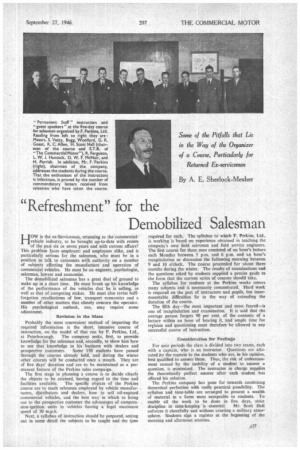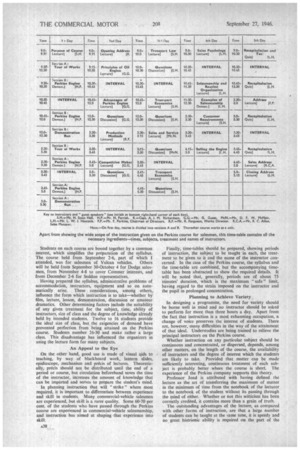"Refreshment" for the Demobilized Salesman
Page 39

Page 40

Page 43

If you've noticed an error in this article please click here to report it so we can fix it.
Some of the Pitfalls that Lie in the Way of the Organizer of a Course. Particularly for Returned Ex-servicemen By A. E. Sherlock-Mesher
How is the ex-Serviceman, returning to the commercialvehicle industry, to be brought up-to-date with events of the past six at seven years and with current affairs? This problem faces enaployers and employees alike, and is particularly serious for the salesman, who must be in a position to talk to customers with authority on a number of subjects affecting the manufacture and operation of commercial vehicles. He must be an engineer, psychologist, salesman, lawyer and economist,
The demobilized salesman has a great deal of ground to make up in a short time. He must brush up his knowledge of the performance of the vehicles that he is selling, as well as that of competing makes. He must also revise halfforgotten recollections of law, transport economies and a number of other matters that closely concern the operator. His psychological outlook, too, may require some adjustment.
Revision in the Mass Probably the most convenient method of imparting the required information is the shots, intensive course of . instruction, on the model of that run by F. Perkins, Ltd., at Peterborough. The company seeks, first, to provide knowledge for the salesman and, secondly, to show him how to use that knowledge in his' business with dealers and prospective customers. Some 150 students have passed through the courses already held, and during the winter other courses Will be conducted once a month. They are of five days' duration and are to be maintained as a permanent feature of the Perkins sales campaign.
The first stage in planning a course is to decide clearly the objects to be attained, having regard to the time and facilities available. The specific objects of the Perkins course are to teach salesmen employed by vehicle manufacturers, distributors and dealers, how to sell oil-engined commercial vehicles, and the best way in which to bring out to the prospective customer the advantages of compression-ignition units in vehicles having a legal maximum speed of 30 m.p.h.
Next, a syllabus of instruction should be prepared, setting out in some detail the subjects to be taught and the time required for each. The syllabus to which F. Perkins, Ltd., is working is based on experience obtained in teaching the company's owe field salesmen and field service engineers. The first course for these men consisted of an hour's lecture each Monday between 5 p.m. and 6 p.m, and an hour's recapitulation or discussion the following morning between 9 and 10 o'clock. The course proceeded for about three months during the winter. •The results of examinations and the questions asked by students supplied a precise guide to the form that the current series of courses should take.
The syllabus for students at the Perkins works covers many subjects and is necessarily concentrated. 'Hard work is required on the part of instructors and pupils, but insurmountable difficulties fie in the way of extending the duration of the course.
The fifth day—the most important and most feared—is one of recapitulation and examination. It is said that the average person forgets 90 per cent. of the contents of a lecture within an hour of hearing it, and ample time for revision and questioning must therefore be 'allowed in any successful course of instruction,
Consideration for Feelings
For quiz periods the class is divided into two teams, each with a captain, who is an instructor. Questions are allocated ,by the 'captain to the students who are, in his opinion, best qualified to answer them. Thus, the risk of embarsassmeat caused by the inability of a student to answer a question, is minimized. The instructor in charge supplies the theoretically perfect answer after each student has offered his solution.
The Perkins company has gone far towards combining theoretical perfection with really practical possibility. The syllabus and time-table are arranged to present a wealth of material in a form most acceptable to students. To enable all the work to be done in five days, strict discipline in time-keeping is essential. Mr. Scott Halt enforces it cheerfully and without creating a military atmosphere. Students sign a register at the beginning of the morning and afternoon sessions. ' Students on each course are bound together by a common interest, which simplifies the preparation of the syllabus. The course held from September 2-6, part of which I
attended, was for salesmen of Vulcan vehicles. Others wit] be held from September 30-October 4 for Dodge salesmen, from November 4-8 to cover Commer interests, and from December 2-6 for Seddon representatives.
Having prepared the syllabus, administrative problems of accommodation, instructors, equipment and so on auto
matically arise. These . considerations, among others, influence the form which instruction is to take-whether by film, lecture, lesson, demonstration, discussion or amateur dramatics. Other determining factors include the suitability of any given treatment for the subject, time, ability of instructors, size of class and the degree of knowledge already held by intended students. Twelve to 16 students provide the ideal size of class, but the exigencies of demand have prevented perfection from being attained on the Perkins course. Students number 26-30 and make rather a large class. This disadvantage has influenced the organizers in using the lecture form for many subjects.
An Appeal to the Eye
On the other hand, good use is made of visual aids to teaching, by way of blackboard work, lantern slides, epidiascope, mechanism and précis of lectures. Theoretically, precis should not be distributed until the end of a • period or course, but circulation beforehand saves the time of the instructor, increases the amount of knowledge that can be imparted and serves to prepare the student's mind.
In planning instruction that will " strike " where most required, it is important to differentiate between experience and skill in students. Many commercial-vehicle salesmen are experienced, but skill is a rarer quality. Some 60-70 per cent. of the students who have passed through the Perkins course are experienced in commercial-vehicle salesmanship, and instruction has aimed at shaping that experience into skill.
Finally, time-tables should be prepared, showing periods of instruction, the subject to be taught in each, the treatment to be given to it and the name of the instructor concerned. In the case of the Perkins course, the syllabus and the time-table are combined, but the accompanying timetable has been abstracted to show the required details. It will be noted that, generally, periods are of about 75 minutes` duration, which is the maximum "safe" limit, having regard to the strain imposed on the instructor and the pupil in prolonged concentration.
Planning to Achieve Variety
In designing a programme, the need for variety should be borne well in mind and no instructor should be asked to perform for more than three hours a day. Apart from the fact that instruction is a most exhausting occupation, a change of voice preserves the interest of students. There are, however, many difficulties in the way of the attainment of that ideal. Understudies are being trained to relieve the principal instructors on the Perkins course, Whether instruction on any particular subject should be continuous and concentrated, or dispersed, depends, among other matters, on the length of the course, the availability of instructors and the degree of interest which the students are likely to take. Provided that matter can be made sufficiently interesting, continuous treatment of each subject is probably better where the course is short. The experience of the Perkins company supports this theory.
Professor load is attributed with having defined the lecture as the art of transferring the maximum of matter in the minimum of time from the notebook of the lecturer to the notebook of the student without its passing through the mind of either. Whether or not this witticism has been correctly credited, it contains more than a grain of truth.
The outstanding advantages of the lecture, as compared with other forms of instruction, are that a large number of students can be taught at the same time, it is speedy and no great histrionic ability is required on the part of the
41
lecturer. Against these ap.dvantages should be set several serious disadvantages. First, the lecture relies too greatly on the aural sense and does not allow great scope for a strong appeal to the eye, through which new information is most readily taken in. Secondly, the instructor has no close contact with his class and he does not know whether the pace he is setting is too hot or too slow.
Educational authorities tell us that interest rises and declines in cycles of 15-20 minutes. Because of its very nature, the lecture cannot make provision for the stimulation of attention when it may reasonably be expected to have waned through the effort of concentration. Moreover, properly to assimilate a lecture, a student must be a good note-taker. Where prospective students have already a reasonable knowledge of the subjects that they are to take, and, if they be keen, these disadvantages are not so significant.
Measuring the Effect of Instruction The Perkins company compromises by allowing ample time for questions at the end of the lectures. Students are invited to ask questions voluntarily. Then, in turn, they ask questions by compulsion and the instructor supplies the answers. Having conducted several courses, the lecturer can arrive at a fair average of the amount of information likely to be taken in by the class at each lecture, and modify his programme or presentation accordingly.
Compared with the cramming process a instruction by lecture, the 'lesson is slow, and calls for showmanship and experience on the part of the instructor, and careful preparation of the matter to be imparted. In particular, it demands the faculty for framing questions in such a way as to produce the desired reaction in the student, and the correct
answers. It is a process of grafting new knowledge on to old—whereas the lecture forces facts on the hearer without first. preparing his mind—and the teacher is in closer contact with his class and can gauge the suitability of his tempo. The lesson is more effective than the lecture, because it requires closer co-operation on the part of the student. The discussion is an even slower method of instruction and is hardly suitable for technical subjects, but is, on the other hand, highly appropriate to subjects such as salesmanship and psychology, which allow for freedom of expression of opinion. A period is devoted in the Perkins course to the demonstration of sales technique. This kind of subject lends itself well to demonstration and to dramatized presentation, in which students or instructors may take part.
Importance of Timing Demonstrations require careful rehearsal. Most ex-Servicemen will have vivid recollections of demonstrations during military courses that failed lamentably because some piece of mechanism resisted all the efforts of its instructor to demonstrate it, or because equipment was not available at the proper time. Timing is, indeed, the essence of all successful instruction, but is particularly important in demonstration.
No normal course of instruction, however good, can do more than show the student how to use his experience and acquire further knowledge during his daily business. He should not be forgotten after he has completed his studies, but should be kept supplied with the latest literature to maintain his interest and enthusiasm. That is the Perkins procedure and has yielded excellent results.




































































